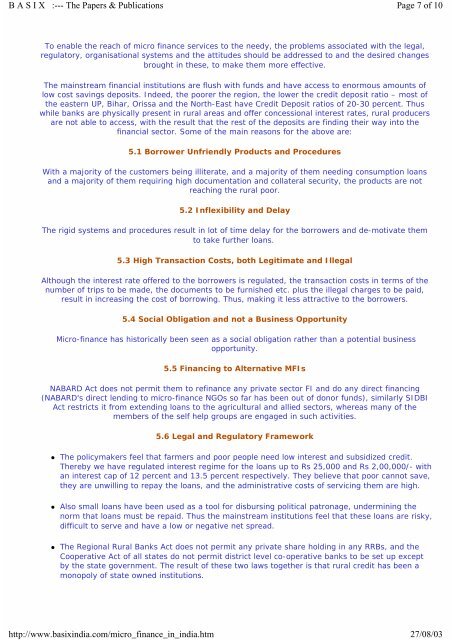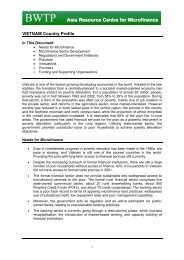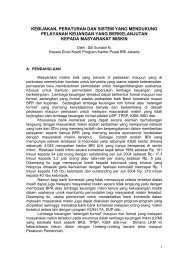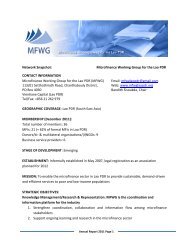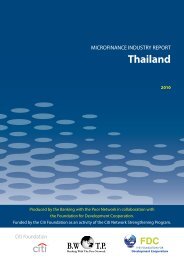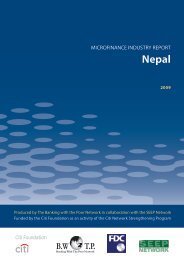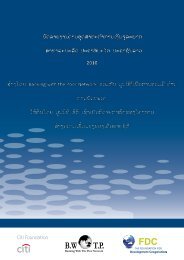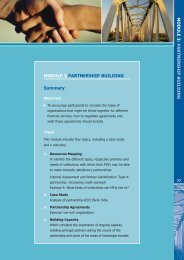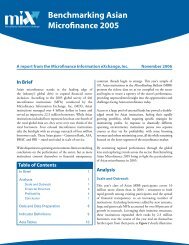Micro Finance in India - Banking with the Poor Network
Micro Finance in India - Banking with the Poor Network
Micro Finance in India - Banking with the Poor Network
You also want an ePaper? Increase the reach of your titles
YUMPU automatically turns print PDFs into web optimized ePapers that Google loves.
B A S I X :--- The Papers & Publications<br />
http://www.basix<strong>in</strong>dia.com/micro_f<strong>in</strong>ance_<strong>in</strong>_<strong>in</strong>dia.htm<br />
Page 7 of 10<br />
27/08/03<br />
To enable <strong>the</strong> reach of micro f<strong>in</strong>ance services to <strong>the</strong> needy, <strong>the</strong> problems associated <strong>with</strong> <strong>the</strong> legal,<br />
regulatory, organisational systems and <strong>the</strong> attitudes should be addressed to and <strong>the</strong> desired changes<br />
brought <strong>in</strong> <strong>the</strong>se, to make <strong>the</strong>m more effective.<br />
The ma<strong>in</strong>stream f<strong>in</strong>ancial <strong>in</strong>stitutions are flush <strong>with</strong> funds and have access to enormous amounts of<br />
low cost sav<strong>in</strong>gs deposits. Indeed, <strong>the</strong> poorer <strong>the</strong> region, <strong>the</strong> lower <strong>the</strong> credit deposit ratio – most of<br />
<strong>the</strong> eastern UP, Bihar, Orissa and <strong>the</strong> North-East have Credit Deposit ratios of 20-30 percent. Thus<br />
while banks are physically present <strong>in</strong> rural areas and offer concessional <strong>in</strong>terest rates, rural producers<br />
are not able to access, <strong>with</strong> <strong>the</strong> result that <strong>the</strong> rest of <strong>the</strong> deposits are f<strong>in</strong>d<strong>in</strong>g <strong>the</strong>ir way <strong>in</strong>to <strong>the</strong><br />
f<strong>in</strong>ancial sector. Some of <strong>the</strong> ma<strong>in</strong> reasons for <strong>the</strong> above are:<br />
5.1 Borrower Unfriendly Products and Procedures<br />
With a majority of <strong>the</strong> customers be<strong>in</strong>g illiterate, and a majority of <strong>the</strong>m need<strong>in</strong>g consumption loans<br />
and a majority of <strong>the</strong>m requir<strong>in</strong>g high documentation and collateral security, <strong>the</strong> products are not<br />
reach<strong>in</strong>g <strong>the</strong> rural poor.<br />
5.2 Inflexibility and Delay<br />
The rigid systems and procedures result <strong>in</strong> lot of time delay for <strong>the</strong> borrowers and de-motivate <strong>the</strong>m<br />
to take fur<strong>the</strong>r loans.<br />
5.3 High Transaction Costs, both Legitimate and Illegal<br />
Although <strong>the</strong> <strong>in</strong>terest rate offered to <strong>the</strong> borrowers is regulated, <strong>the</strong> transaction costs <strong>in</strong> terms of <strong>the</strong><br />
number of trips to be made, <strong>the</strong> documents to be furnished etc. plus <strong>the</strong> illegal charges to be paid,<br />
result <strong>in</strong> <strong>in</strong>creas<strong>in</strong>g <strong>the</strong> cost of borrow<strong>in</strong>g. Thus, mak<strong>in</strong>g it less attractive to <strong>the</strong> borrowers.<br />
5.4 Social Obligation and not a Bus<strong>in</strong>ess Opportunity<br />
<strong>Micro</strong>-f<strong>in</strong>ance has historically been seen as a social obligation ra<strong>the</strong>r than a potential bus<strong>in</strong>ess<br />
opportunity.<br />
5.5 F<strong>in</strong>anc<strong>in</strong>g to Alternative MFIs<br />
NABARD Act does not permit <strong>the</strong>m to ref<strong>in</strong>ance any private sector FI and do any direct f<strong>in</strong>anc<strong>in</strong>g<br />
(NABARD's direct lend<strong>in</strong>g to micro-f<strong>in</strong>ance NGOs so far has been out of donor funds), similarly SIDBI<br />
Act restricts it from extend<strong>in</strong>g loans to <strong>the</strong> agricultural and allied sectors, whereas many of <strong>the</strong><br />
members of <strong>the</strong> self help groups are engaged <strong>in</strong> such activities.<br />
5.6 Legal and Regulatory Framework<br />
! The policymakers feel that farmers and poor people need low <strong>in</strong>terest and subsidized credit.<br />
Thereby we have regulated <strong>in</strong>terest regime for <strong>the</strong> loans up to Rs 25,000 and Rs 2,00,000/- <strong>with</strong><br />
an <strong>in</strong>terest cap of 12 percent and 13.5 percent respectively. They believe that poor cannot save,<br />
<strong>the</strong>y are unwill<strong>in</strong>g to repay <strong>the</strong> loans, and <strong>the</strong> adm<strong>in</strong>istrative costs of servic<strong>in</strong>g <strong>the</strong>m are high.<br />
! Also small loans have been used as a tool for disburs<strong>in</strong>g political patronage, underm<strong>in</strong><strong>in</strong>g <strong>the</strong><br />
norm that loans must be repaid. Thus <strong>the</strong> ma<strong>in</strong>stream <strong>in</strong>stitutions feel that <strong>the</strong>se loans are risky,<br />
difficult to serve and have a low or negative net spread.<br />
! The Regional Rural Banks Act does not permit any private share hold<strong>in</strong>g <strong>in</strong> any RRBs, and <strong>the</strong><br />
Cooperative Act of all states do not permit district level co-operative banks to be set up except<br />
by <strong>the</strong> state government. The result of <strong>the</strong>se two laws toge<strong>the</strong>r is that rural credit has been a<br />
monopoly of state owned <strong>in</strong>stitutions.


